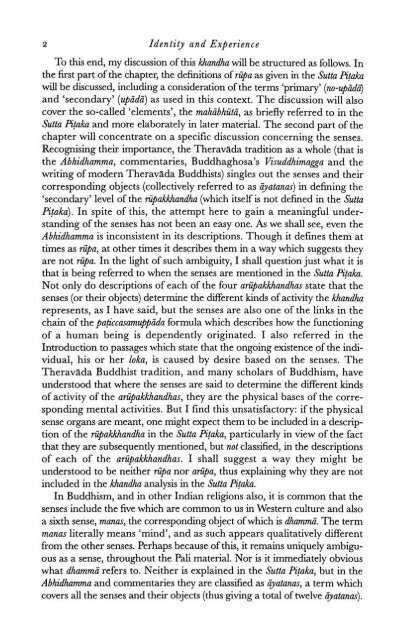Identity and Experience_Hamilton_1996
Identity and Experience_Hamilton_1996
Identity and Experience_Hamilton_1996
Create successful ePaper yourself
Turn your PDF publications into a flip-book with our unique Google optimized e-Paper software.
2 <strong>Identity</strong> <strong>and</strong> <strong>Experience</strong><br />
To this end, my discussion of this kh<strong>and</strong>ha will be structured as follows. In<br />
the first part of the chapter, the definitions of rEpa as given in the Sutta Waka<br />
will be discussed, including a consideration of the terms 'primary' (no-updq<br />
<strong>and</strong> 'secondary' (upida') as used in this context. The discussion will also<br />
cover the so-called 'elements', the mahiibhiiti, as briefly referred to in the<br />
Sutta @aka <strong>and</strong> more elaborately in later material. The second part of the<br />
chapter will concentrate on a specific discussion concerning the senses.<br />
Recognising their importance, the Theravada tradition as a whole (that is<br />
the Abhidhamma, commentaries, Buddhaghosa's Visuddhimagga <strong>and</strong> the<br />
writing of modern Theravada Buddhists) singles out the senses <strong>and</strong> their<br />
corresponding objects (collectively referred to as eatanas) in defining the<br />
'secondary' level of the riipam<strong>and</strong>ha (which itself is not defined in the Sutta<br />
Pitaka). In spite of this, the attempt here to gain a meaningful underst<strong>and</strong>ing<br />
of the senses, has not been an easy one. As we shall see, even the<br />
Abhidhamma is inconsistent in its descriptions. Though it defines them at<br />
times as nipa, at other times it describes them in a way which suggests they<br />
are not riipa. In the light of such ambiguity, I shall question just what it is<br />
that is being referred to when the senses are mentioned in the Sutta Pitaka.<br />
Not only do descriptions of each of the four ariipakkh<strong>and</strong>has state that the<br />
senses (or their objects) determine the different kinds of activity the Wl<strong>and</strong>ha<br />
represents, as I have said, but the senses are also one of the links in the<br />
chain of the paticcmmupp2da formula which describes how the functioning<br />
of a human being is dependently originated. I also referred in the<br />
Introduction to passages which state that the ongoing existence of the individual,<br />
his or her loka, is caused by desire based on the senses. The<br />
Theravada Buddhist tradition, <strong>and</strong> many scholars of Buddhism, have<br />
understood that where the senses are said to determine the different kinds<br />
of activity of the ariipakkh<strong>and</strong>has, they are the physical bases of the corresponding<br />
mental activities. But I find this unsatisfactory: if the physical<br />
sense organs are meant, one might expect them to be included in a description<br />
of the riipakkh<strong>and</strong>ha in the Sutta Pi!aka, particularly in view of the fact<br />
that they are subsequently mentioned, but not classified, in the descriptions<br />
of each of the ariipakkh<strong>and</strong>has. I shall suggest a way they might be<br />
understood to be neither riipa nor arzipa, thus explaining why they are not<br />
included in the kh<strong>and</strong>ha analysis in the Sutta Pitaka.<br />
In Buddhism, <strong>and</strong> in other Indian religions also, it is common that the<br />
senses include the five which are common to us in Western culture <strong>and</strong> also<br />
a sixth sense, manas, the corresponding object of which is dhammi. The term<br />
manas literally means 'mind', <strong>and</strong> as such appears qualitatively different<br />
from the other senses. Perhaps because of this, it remains uniquely ambiguous<br />
as a sense, throughout the Pali material. Nor is it immediately obvious<br />
what dhammi refers to. Neither is explained in the Sutta maka, but in the<br />
Abhidhamma <strong>and</strong> commentaries they are classified as eatanas, a term which<br />
covers all the senses <strong>and</strong> their objects (thus giving a total of twelve gatanas).


